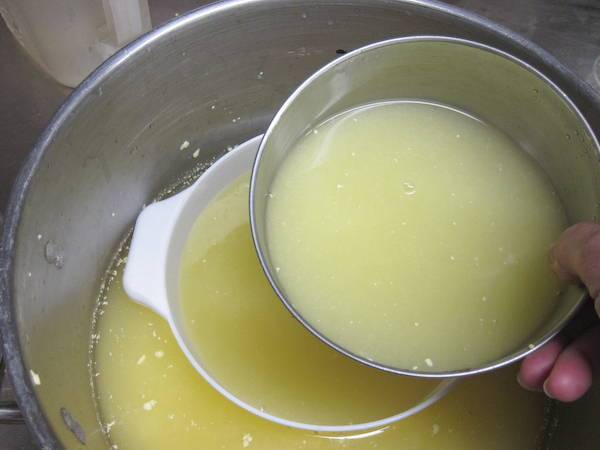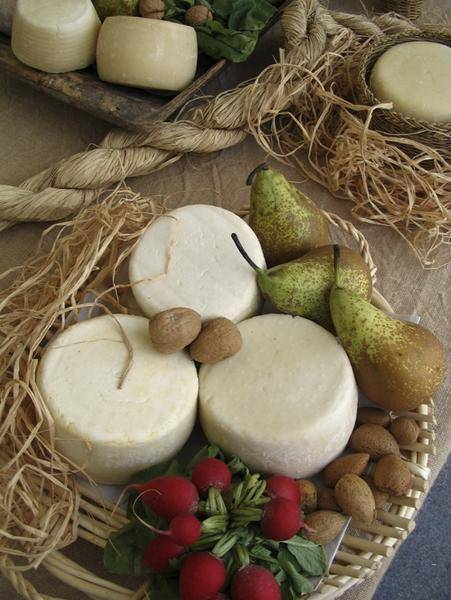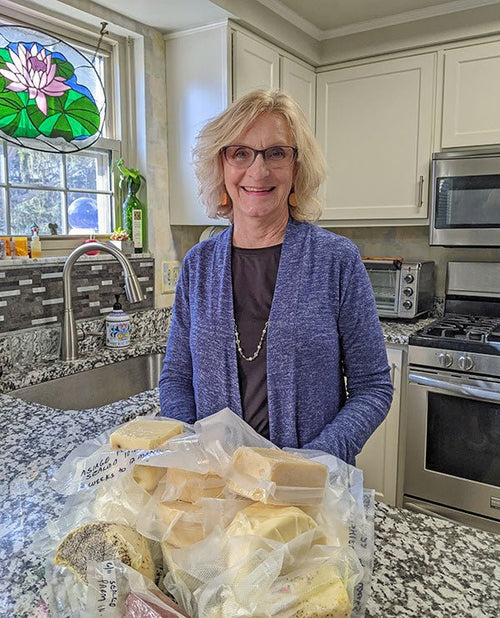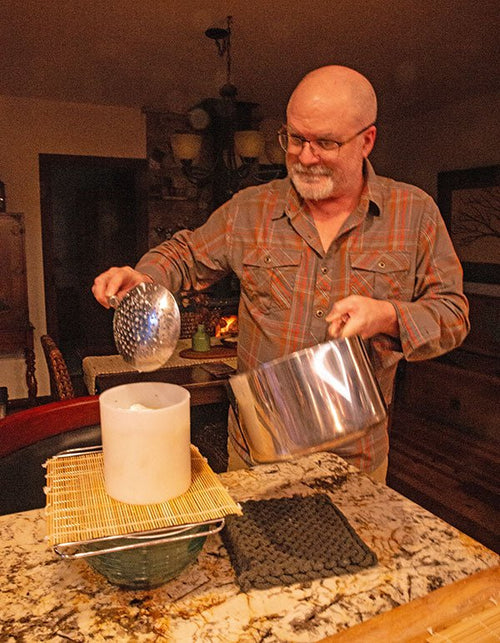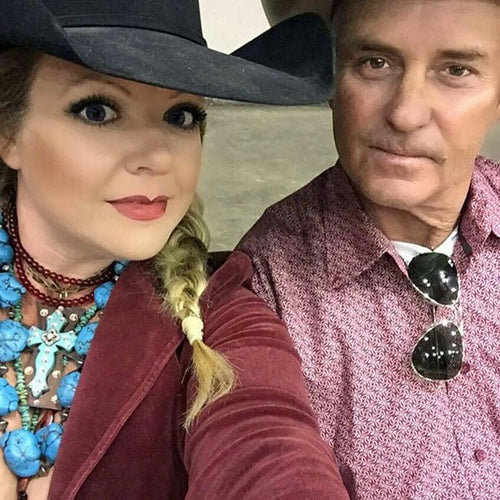Cheese Making Recipe of the Month
Bleu d'Auvergne
Jim travels around the globe, visiting the people who make the fabulous artisan cheeses we know and love. When he finds these cheese makers, he samples their cheese and studies their techniques so that we can all benefit from their expertise. (It's a hard job but someone has to do it!)
One of his trips, not too long ago, was to the beautiful Auvergne province of France where there are 80 dormant volcanoes, the last eruption was around 6,000 years ago.
It's one of the least populated regions in Europe (for humans), but the cow population is gigantic. They graze on the rich, volcanic soil, producing milk perfect for the cheeses from the area, including Cantal, Fourme d'Ambert, Saint-Nectaire and, of course, the fabulous Bleu d"Auvergne.
This is a mild and creamy cow's milk cheese with less salt in it than most blues. It's often used in salad dressings and pasta sauces when it isn't the center of a cheese board.
Jim LOVES this cheese, and he highly recommends it. So, if you have some experience under your belt, you may want to give this intermediate level cheese a try. The result will be a stunning addition to your repertoire.
Cheese Making Questions & Answers
Drying Your Cheese
Q. I followed the directions in the Basic Cheese Making Kit and I have a question. My instructions said to dry the cheese at room temperature, which I'm doing. It's sitting on the counter, on a cheese mat lightly covered with a paper towel to keep dust and stuff off. It's beginning to develop some mold on the surface, which I will wipe off with salt water, but I'm wondering if it's ruined because it wasn't kept in a cheese cave, which I don't have?
A. Drying the cheese is more a matter of where you are drying it - warm temperatures and high moisture make it somewhat problematic. What you need to watch for is the loss of surface moisture and a slight darkening of the surface with no cracking (which would mean it is too dry).
Regarding the cheese cave, it is best to have a cool and moderately moist place to age your cheese. Waxing can help protect the cheese, especially when it is a smaller cheese. Most guidelines for cheese making need to be followed closely to get to the end result desired.
Culturing 30 Gallons
Q. I would like to know how much culture I need to make a 30 gallon batch of cheese curds? The recipe online calls for 1 packet / 2 gallons.
A. Depending on your milk source, if you are using our small culture packs you will need 10-15. However, with this much milk, you can use the larger culture packs and have 2 options:
- You could make a low temperature version using MA001, heating the milk initially to 86F then slowly heating to 102F, resulting in a traditional, yet softer curd.
- In the higher temperature method, you can use TA061, heating the milk initially to 96F and then slowly to 108-116F. This will result in a drier curd and squeakier texture.
The amounts for these large pack cultures will depend on whether you are using pasteurized or raw milk. Use 1.25 tsp of the culture from the larger pack if using raw milk and 30-40% more if using pasteurized milk.
Maintaining Humidity
Q. I just made a batch of Jack cheese and I have my refrigerator at 50F. However, I can only get the humidity up to 62 percent. What do I do?
A. Pans of water and sometimes damp cloths need to be hung in the fridge to keep the moisture level. It is best to have these storage fridges sized to fit your production. With just a single cheese or two, it is hard to keep the moisture up. Make sure you have a reliable hygrometer.
Making Better Butter?
Q. I found your site through a search on how to make homemade butter. I bought heavy cream and put it into a blender. It started to separate, and then suddenly it all just turned to liquid again, and I had to throw it out. What did I do wrong?
A. If you used too high a speed, this could cause the butter to break out. You can use a blender, but only on 'stir.' It is also important to make sure the cream is chilled into the mid 50's(F)- too cold or too warm creates problems. Also, ripening the cream with a little buttermilk culture will help the butter form more evenly
No buttermilk to be found. Very tasty, but perhaps like a very whipped butter?
Q. Quick question about making cultured butter: I used local farm cream plus your buttermilk enzyme, as per the directions. Problem is, I had to leave on short notice and didn't return until much later - at least 36 hours after I set the covered pot in a quiet place. When I came back it was thick - REALLY thick. I tried to shake it in a mason jar as I had done (successfully) in the past, but rather than separating into butter and buttermilk, I got one very thick product the consistency (almost) of mayonnaise. No buttermilk to be found. Very tasty, but perhaps like a very whipped butter. Not as sweet as a thick whipped cream, but very tasty still. What went wrong? Was it the time I spent away? How much time is the maximum I could give this to work?
A. 36 hrs was too long a ripening time ... do it overnight, 8-10 hrs and usually below 60F. Too much acid and you will be well on your way to a very tangy lactic cheese. In that case, the acidity is high enough to pull the proteins together to form a good yogurt-like consistency. At this point, butter making is problematic. Drain it through a double layer of our butter muslin for a nice sour cream.
Have a cheese making question, we're here for you: info@cheesemaking.com
Meet a Fellow Cheese Maker
Phil Tillman in Arroyo Grande, CA
Phil Tillman is a retired veterinarian with a much beloved Nubian named Rain. Rain gave Phil and his family over a gallon of rich, creamy milk daily for many months after she had her first kid.
So, what could he do but make cheese? He became a cheese maker and now his wife barters (very successfully) with it at the local farmer's market.
Phil wrote to Jim Wallace recently regarding Jim's page, The Whey of the World. There's some good info in his note, so we'll share it with you:
You mention that you tend to use only sweet whey for plants. I suppose this is to be expected in East coast areas where some people even have to add lime to their soil to make it less acid.
In most of the arid regions of the Southwest (I live in California), the biggest single soil problem is alkalinity. Citrus looks sick and yellow, camelias, azaleas and rhododendrons need to be put in raised beds with artificial soil, and hydrangeas can't be made blue no matter how much sulfur one tries to water in around their base. People (futilely) water iron sulfate in around their plants to no avail, because the alkaline soil renders the iron unavailable no matter how much you add.
News From Fellow Cheese Makers
ChefAlarm (E22)
Sarah's always on the lookout for new products to make your life easier. (Of course, it's a bonus if they look cute and come in a wide variety of colors.) This alarm is a must for multi-taskers. You set it and go back to that other project you have going, only, now you don't have to worry about your pot of milk.
You may be asking yourself - how exactly would I use this? and the answer is right on our website:
Uses for Yogurt Making:
- Set the MAX ALARM to know when the temp of milk reaches 185F.
- Then, set the TIMER ALARM for 20 minutes to hold it there (the MIN ALARM set to 180F will let you know if heat needs to be increased).
- Then, set the MIN ALARM to 115F to avoid over chilling the milk before adding culture.
Uses for Cheese Making:
- Set the MAX ALARM to just below target milk temp to avoid overheating the milk.
- Use to monitor the temperature of milk during slow heating using the TEMP and TIMER settings.
- Set the MIN ALARM once the cheese curd is at temp to know when more heating is needed.
- Set the MIN ALARM for cheeses that need to be held at a specific temp while cultures remain active after draining/molding (such as many soft or lightly pressed cheeses).
Please send your cheese making news & photos to: moosletter@cheesemaking.com































